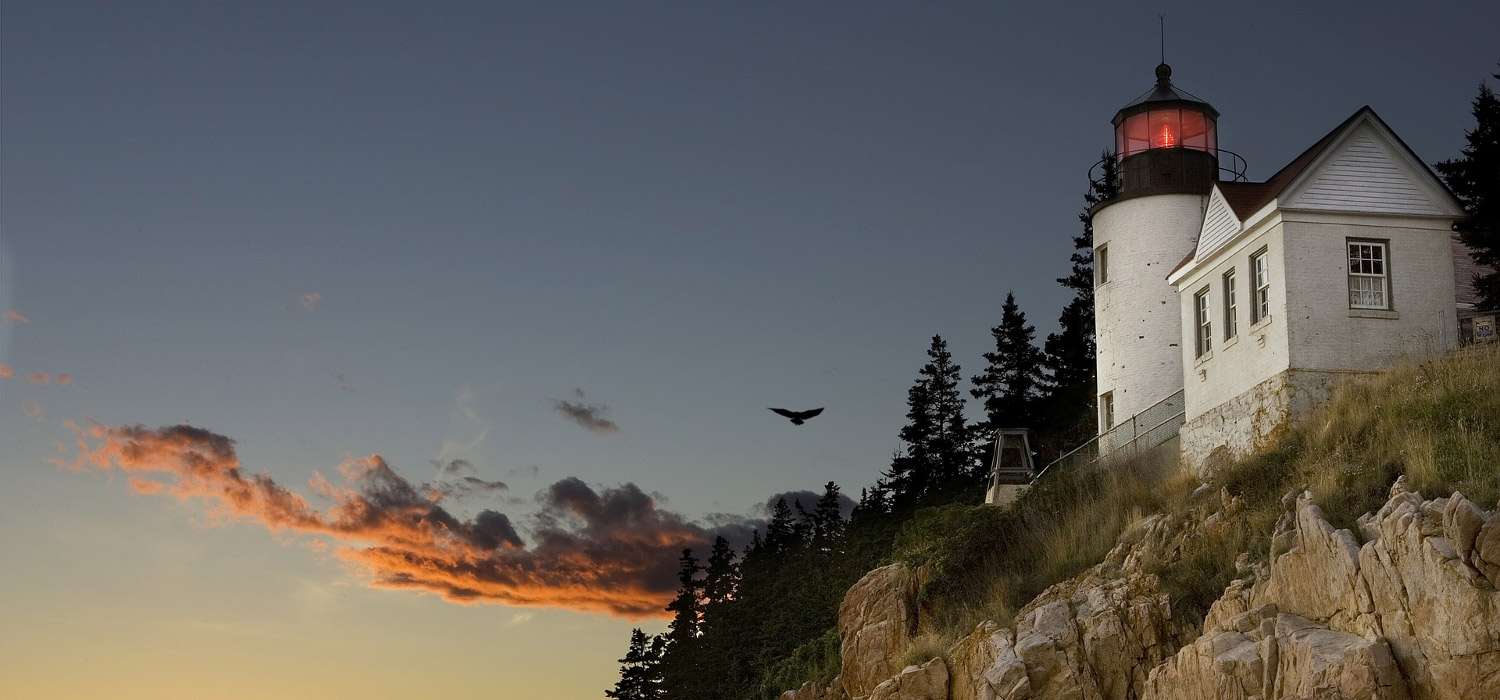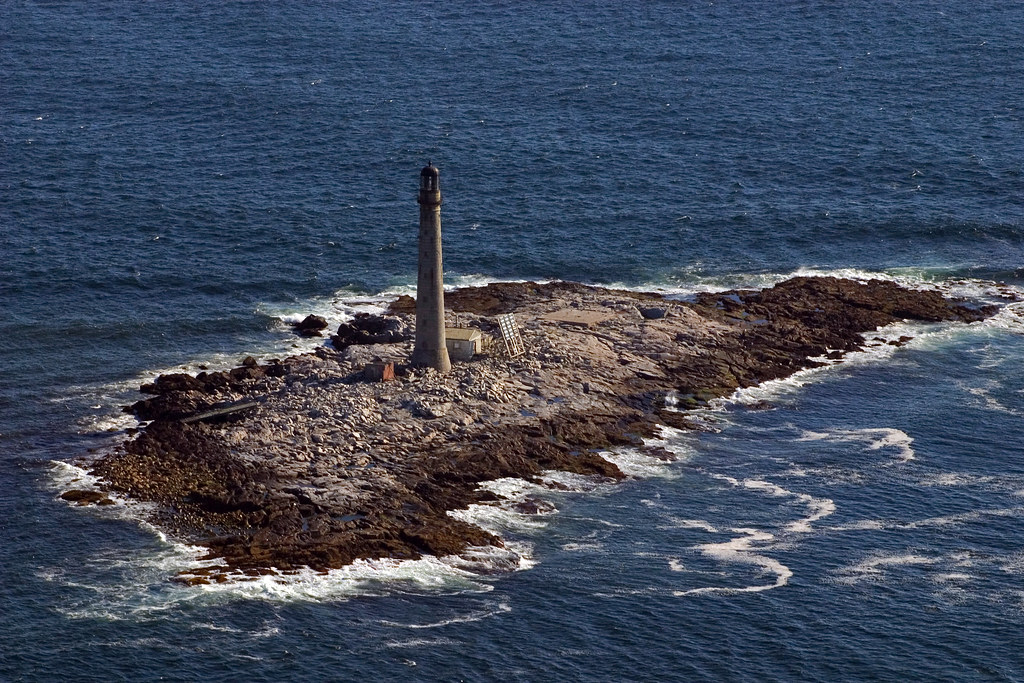Photo by Jeremy D'Entremont (All rights reserved)
Boon Island Light is located on the 300-by-700-foot (91 m × 213 m) Boon Island off the southern coast of Maine, United States, near Cape Neddick. Boon Island Light has the distinction of being the tallest lighthouse in both Maine and New England at 133 feet (41 m). The lighthouse has a focal plane at 137 feet (42 m) above mean high water. The light's beacon flashes white every 5 seconds.
Content Provided by wikipedia.org
Location: BOON ISLAND, NINE MILES OFF THE COAST OF YORK BEACH, YORK, MAINE
Station Established: 1811
Year Current Tower(s) First Lit: 1855
Operational? YES
Automated? 1980
Deactivated: N/A
Foundation Materials: SURFACE ROCK
Construction Materials: GRANITE
Tower Shape: CYLINDRICAL
Markings/Pattern: NATURAL
Relationship to Other Structure: SEPARATE
Original Lens: SECOND ORDER FRESNEL
Content provided by United States Coast Guard
Historical Information:
- Boon Island is an inhospitable piece of land about 9 miles from the coast of York, Maine. The first lighthouse on Boon Island was a 50 foot wooden tower built in 1799. It lasted five years before a storm destroyed it.
- A stone day beacon was erected to replace the wooden tower. It was used until 1811 when a new tower was built. At this time the station was officially established. The tower was only 32 feet above sea level and was destroyed in a storm in 1832.
- Finally a tower that could stand the storms of the Atlantic was built. A stone 133 foot tower was built in 1855. The tower is 25 feet in diameter at the base and 12 feet at the top. It is the tallest lighthouse in New England from base to tip but it is not the highest light above sea level. A new keeper’s dwelling was also built at this time.
- In 1899 the keeper’s house was basically rebuilt and a second story was added.
- The harsh conditions and frequent, violent storms led to most keepers staying just a few years.
- The light was still manned until the blizzard of 1978 struck. That storm flooded the keeper’s house with five feet of water and scattered boulders all over the island. The keepers sought refuge in the tower. They had to be rescued by helicopter.
- Shortly after that storm the light was automated. The second order Fresnel lens was removed in 1993 and replaced by a modern optic. The original lens is on display in the Kittery Historical and Naval Museum in Kittery, Maine.
- In May 2000 the Coast Guard licensed the light to the American Lighthouse Foundation. The light remains an active aid to navigation but is not open to the public


Content provided by United States Coast Guard
Keepers:
- David Oliver (c. 1811)
- Thomas Hanna (c. 1811-1816)
- Eliphalet Grover (1816–1839)
- Mark Dennet (1840–1841)
- John Thompson (1841–1843)
- Morgan Trafton (1842 assistant keeper, lost in boating accident)
- John Kennard (1843–1846)
- Nathaniel Baker (1849)
- John Thompson (1846–1849)
- Hiram Tobey (1853)
- Caleb S. Gould (1853–1854)
- George Bowden (1854–1855)
- Josiah Tobey Jr. (assistant, 1855)
- Samuel S. Tobey (assistant, 1856)
- Christopher Littlefield (1854)
- Sam Philbrick (1854)
- Charles H. Tobey (assistant 1850, keeper 1856)
- Charles E. Thompson (1858)
- John S. Baker (assistant, 1858)
- Nathaniel Baker (1859)
- William L. Baker (assistant, 1859)
- Cabin (?) Gray (1861)
- George B. Wallace (June 1861 – 1866)
- Benjamin Bridges (1861)
- George E. Bridges (1864)
- Richard C. Yeaton (1864)
- Charles Ramsdell (assistant 1865)
- Joshua K. Card (1867–1874)
- George H. Yeaton (assistant 1867)
- Samuel Meloon (assistant, 1868)
- Nathan White Jr. (assistant 1870)
- Alfred J. Leavitt (1874-1886?)
- Leander White (1st assistant, 1874)
- Edwin J. Hobbs (assistant, 1874–1876)
- David R. Grogan (assistant, 1876, keeper 1879)
- George O. Leavitt (assistant, 1878)
- Walter S. Amee (Ames?) (2nd assistant, 1878)
- John Kennard (1884)
- William C. Williams (1st assistant 1885, then keeper 1885-1911)
- James Burke (2nd assistant, 1886–1887, 1st assistant 1887-1890)
- Orrin M. Lamprey (1886)
- Meshach M. Seaward (2nd assistant, 1886–1900)
- Leonidas H. Sawyer (2nd assistant, 1889. keeper 1889)
- Charles W. Allen (2nd assistant, 1907–1911, first assistant 1911-?)
- Mitchell Blackwood (c. 1911)
- Harold Hutchins (c. 1923-1933)
- Fred C. Batty (assistant, c. early 1930s)
- Clinton Dalzell (assistant c. 1934)
- George Woodward (assistant?, c. 1920s)
- C. A. Tracy (c. 1935)
- Hoyt P. Smith (c. 1935)
- E. Stockbridge, assistant (c. 1935)
- Charles U. Gardner (Coast Guard relief keeper, c, 1942–1943)
- John H. Morris (Coast Guard, c. 1945)
- Ted Guice (Coast Guard assistant, c. 1945)
- Kendrick Capon (Coast Guard, c. 1950s)
- Harold L. Roberts (Coast Guard, 1956)
- Leonard John "Moon" Mullen (Coast Guard, c.1956)
- Charles Allen (1st assistant, c. 1957, served 6 years)
- Robert Brann (c. 1958)
- Dave Wells (Coast Guard, 1966)
- August "Gus" Pfister (Coast Guard, 1967–1968)
- Thomas Lee (Coast Guard, 1970-1971)
- Bob Roberts (Coast Guard, 1970s)
- Fred Kendall (1973–1975)
Content Provided by wikipedia.org
Researched and written by Melissa Buckler, a volunteer through the Chesapeake Chapter of the U.S. Lighthouse Society.
Content provided by www.uscg.mil and wikipedia.org


